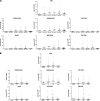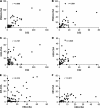Evaluation of the antigenic diversity of placenta-binding Plasmodium falciparum variants and the antibody repertoire among pregnant women
- PMID: 20160014
- PMCID: PMC2863515
- DOI: 10.1128/IAI.01365-09
Evaluation of the antigenic diversity of placenta-binding Plasmodium falciparum variants and the antibody repertoire among pregnant women
Abstract
Pregnant women are infected by specific variants of Plasmodium falciparum that adhere and accumulate in the placenta. Using serological and molecular approaches, we assessed the global antigenic diversity of surface antigens expressed by placenta-binding isolates to better understand immunity to malaria in pregnancy and evolution of polymorphisms and to inform vaccine development. We found that placenta-binding isolates originating from all major regions where malaria occurs were commonly recognized by antibodies in different populations of pregnant women. There was substantial antigenic overlap and sharing of epitopes between isolates, including isolates from distant geographic locations, suggesting that there are limitations to antigenic diversity; however, differences between populations and isolates were also seen. Many women had cross-reactive antibodies and/or a broad repertoire of antibodies to different isolates. Studying VAR2CSA as the major antigen expressed by placenta-binding isolates, we identified antibody epitopes encoded by variable sequence blocks in the DBL3 domain. Analysis of global var2csa DBL3 sequences demonstrated that there was extensive sharing of variable blocks between Africa, Asia, Papua New Guinea, and Latin America, which likely contributes to the high level of antigenic overlap between different isolates. However, there was also evidence of geographic clustering of sequences and differences in VAR2CSA sequences between populations. The results indicate that there is limited antigenic diversity in placenta-binding isolates and may explain why immunity to malaria in pregnancy can be achieved after exposure during one pregnancy. Inclusion of a limited number of variants in a candidate vaccine may be sufficient for broad population coverage, but geographic considerations may also have to be included in vaccine design.
Figures







Similar articles
-
Genetic diversity of VAR2CSA ID1-DBL2Xb in worldwide Plasmodium falciparum populations: impact on vaccine design for placental malaria.Infect Genet Evol. 2014 Jul;25:81-92. doi: 10.1016/j.meegid.2014.04.010. Epub 2014 Apr 21. Infect Genet Evol. 2014. PMID: 24768682
-
Antigenic differences and conservation among placental Plasmodium falciparum-infected erythrocytes and acquisition of variant-specific and cross-reactive antibodies.J Infect Dis. 2006 Mar 1;193(5):721-30. doi: 10.1086/500145. Epub 2006 Jan 30. J Infect Dis. 2006. PMID: 16453269 Free PMC article.
-
VAR2CSA binding phenotype has ancient origin and arose before Plasmodium falciparum crossed to humans: implications in placental malaria vaccine design.Sci Rep. 2019 Nov 18;9(1):16978. doi: 10.1038/s41598-019-53334-8. Sci Rep. 2019. PMID: 31740695 Free PMC article.
-
Cytoadhesion of Plasmodium falciparum-infected erythrocytes and the infected placenta: a two-way pathway.Braz J Med Biol Res. 2006 Dec;39(12):1525-36. doi: 10.1590/s0100-879x2006001200003. Braz J Med Biol Res. 2006. PMID: 17160261 Review.
-
Antigenic diversity of Plasmodium falciparum and antibody-mediated parasite neutralization.Scand J Immunol. 2000 Sep;52(3):233-9. doi: 10.1046/j.1365-3083.2000.00787.x. Scand J Immunol. 2000. PMID: 10972898 Review.
Cited by
-
A single point in protein trafficking by Plasmodium falciparum determines the expression of major antigens on the surface of infected erythrocytes targeted by human antibodies.Cell Mol Life Sci. 2016 Nov;73(21):4141-58. doi: 10.1007/s00018-016-2267-1. Epub 2016 May 19. Cell Mol Life Sci. 2016. PMID: 27193441 Free PMC article.
-
PTEX is an essential nexus for protein export in malaria parasites.Nature. 2014 Jul 31;511(7511):587-91. doi: 10.1038/nature13555. Epub 2014 Jul 16. Nature. 2014. PMID: 25043043
-
The Development, Fine Specificity, and Importance of High-Avidity Antibodies to VAR2CSA in Pregnant Cameroonian Women Living in Yaoundé, an Urban City.Front Immunol. 2021 Feb 26;12:610108. doi: 10.3389/fimmu.2021.610108. eCollection 2021. Front Immunol. 2021. PMID: 33717094 Free PMC article.
-
Evaluating antibody functional activity and strain-specificity of vaccine candidates for malaria in pregnancy using in vitro phagocytosis assays.Parasit Vectors. 2018 Jan 29;11(1):69. doi: 10.1186/s13071-018-2653-7. Parasit Vectors. 2018. PMID: 29378634 Free PMC article.
-
Surface antigens of Plasmodium falciparum-infected erythrocytes as immune targets and malaria vaccine candidates.Cell Mol Life Sci. 2014 Oct;71(19):3633-57. doi: 10.1007/s00018-014-1614-3. Epub 2014 Apr 2. Cell Mol Life Sci. 2014. PMID: 24691798 Free PMC article. Review.
References
-
- Avril, M., B. R. Kulasekara, S. O. Gose, C. Rowe, M. Dahlbäck, P. E. Duffy, M. Fried, A. Salanti, L. Misher, D. L. Narum, and J. D. Smith. 2008. Evidence for globally shared, cross-reacting polymorphic epitopes in the pregnancy malaria vaccine candidate VAR2CSA. Infect. Immun. 74:1791-1800. - PMC - PubMed
-
- Awadalla, P. 2003. The evolutionary genomics of pathogen recombination. Nat. Rev. Genet. 4:50-60. - PubMed
-
- Barfod, L., N. L. Bernasconi, M. Dahlback, D. Jarrossay, P. H. Andersen, A. Salanti, M. F. Ofori, L. Turner, M. Resende, M. A. Nielsen, T. G. Theander, F. Sallusto, A. Lanzavecchia, and L. Hviid. 2007. Human pregnancy-associated malaria-specific B cells target polymorphic, conformational epitopes in VAR2CSA. Mol. Microbiol. 63:335-347. - PMC - PubMed
Publication types
MeSH terms
Substances
Associated data
- Actions
- Actions
- Actions
- Actions
- Actions
- Actions
- Actions
- Actions
- Actions
- Actions
- Actions
- Actions
- Actions
- Actions
- Actions
- Actions
- Actions
- Actions
- Actions
- Actions
- Actions
- Actions
- Actions
- Actions
- Actions
- Actions
- Actions
- Actions
- Actions
- Actions
- Actions
- Actions
- Actions
- Actions
- Actions
- Actions
- Actions
- Actions
- Actions
- Actions
- Actions
- Actions
- Actions
- Actions
- Actions
- Actions
- Actions
- Actions
- Actions
- Actions
- Actions
- Actions
- Actions
- Actions
- Actions
- Actions
- Actions
- Actions
- Actions
- Actions
- Actions
- Actions
- Actions
- Actions
- Actions
- Actions
- Actions
- Actions
- Actions
- Actions
- Actions
- Actions
- Actions
- Actions
- Actions
- Actions
- Actions
- Actions
- Actions
- Actions
- Actions
- Actions
- Actions
- Actions
- Actions
- Actions
- Actions
- Actions
- Actions
- Actions
- Actions
- Actions
- Actions
- Actions
- Actions
- Actions
- Actions
- Actions
- Actions
- Actions
- Actions
- Actions
- Actions
- Actions
- Actions
- Actions
- Actions
- Actions
- Actions
- Actions
- Actions
- Actions
- Actions
- Actions
- Actions
Grants and funding
LinkOut - more resources
Full Text Sources
Medical

